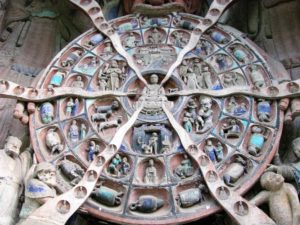The Bhavacakra, or Tibetan Wheel of Life, is a graphic depiction of Tibetan Buddhism’s philosophy of existence. Although there are several versions of the Wheel of Life, the symbols maintain their meanings. The symbols found in the Bhavacakra describe the theory of causality that is central to karma. The whole of existence, samsara (the repetitive cycle of birth, life, and death) and liberation by enlightenment is revealed in the Bhavacakra.
Yama, the Lord of Death, turns the wheel. Yama is central because the impermanence of all life is a primary Buddhist tenet and was the key instigator to the Buddha’s awakening. In the Wheel of Life, because the Buddha is the “Awakened One,” he is outside of the wheel. The Buddha points to Nirvana, liberation symbolized by the moon.
The symbols in the inner wheel are the three root delusions. The snake symbolizes hatred, the rooster stands for ignorance and the pig symbolizes greed. The ring around the center is karma, the principle of causality that attends every part of life. The figures on the left are rising toward the higher realms for their virtuous actions. Contrasted are the figures on the right, who, based on ignorant actions, are descending to the lower realms of existence.
The areas between the spokes signify the six realms of existence.
The higher three are represented by humans, gods, and demi-gods. The lower three realms are symbolized by animals, hell-beings and hungry ghosts. Animals are confined to a lower realm in fear and ignorance. The hells are products of our own consciousness. Hungry ghosts cannot eat or drink and are still attached by their desire for this world. The in-between states are the Tibetan bardo, also a condition of dreaming consciousness.
The twelve links of Dependent Origin
This is a wheel of causality that describes the causal chain of existence. Moving clockwise from the top: A blind man symbolizes ignorance, the true nature of existence. In this state of spiritual blindness, we easily lose our way. The potter follows, symbolizing that humans mold our own destiny by our actions. Fate is not a factor.
The monkey is the restlessness of ordinary attention. He is calmed by meditation. The people in the boat are the name and form the arise from consciousness. Next is an empty house, the doors and windows are the developing sense organs by which we experience the world. The lovers are the six senses (the sixth sense is apperception, subconscious recognition), human contact with the world. From contact follows feelings, symbolized by the arrow in the eye. This is the wound or the suffering that results from feelings.
The man drinking shows the movement from feelings to the attachment as we drink in the world. The monkey picking fruit symbolizes the grasping that follows attachment. We become more immersed in the sensory aspect of existence. The man and woman making love depict that grasping leads to the existence, which is followed by the woman in childbirth. Birth the natural result of existence and entrance into the human realm. Finally, the old man burdened symbolizes the inevitable move from birth to old age and death. This is the key experience of Siddhartha Gautama, which led to his awakening.
This all portrays the unacceptable condition of samsara, the only viable release is offered outside the wheel, by the Awakened One, Buddha.





